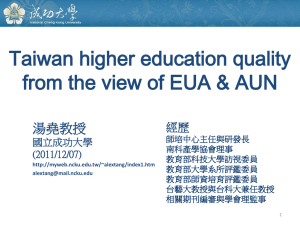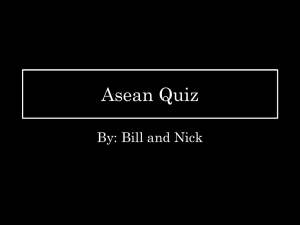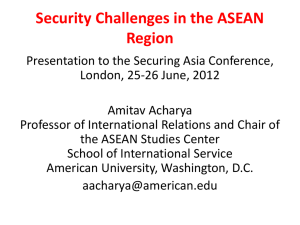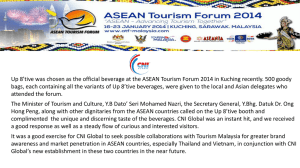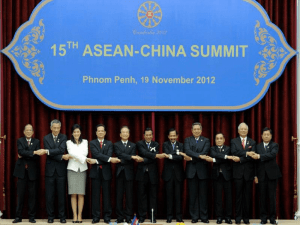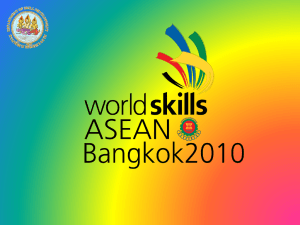Govern. Decree
advertisement
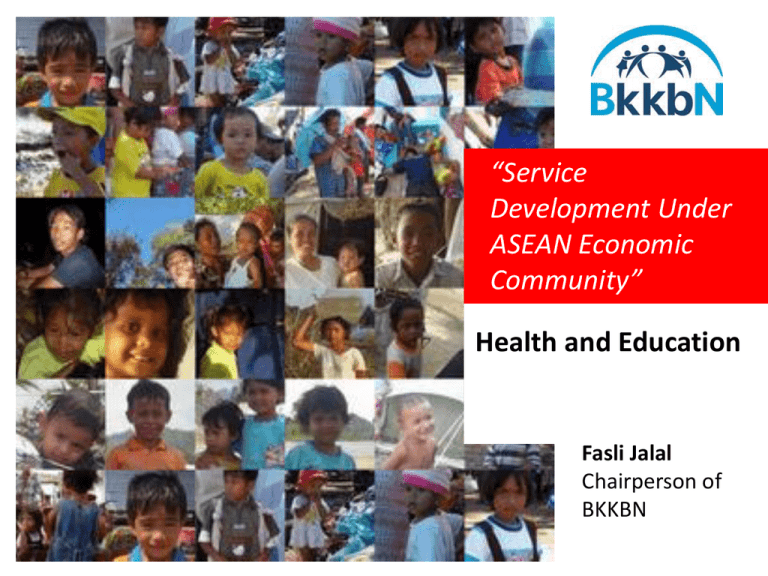
“Service Development Under ASEAN Economic Community” Health and Education Fasli Jalal Chairperson of BKKBN INDONESIA among ASEAN COUNTRIES Basic Demographic Indication Demographic transition is taking place at among the fastest rates compared with other regions of the world, whether in terms of fertility reductions, population ageing, and rural-tourban migration. Rapid epidemiological transition is also occurring, with the disease burden shifting from infectious to chronic diseases. Availability of Health Workers in South East Asia Kanchanachitra C, Lindelow M, Johnston T, Hanvoravongchai P, Lorenzo FM, Huong NL, Wilopo SA, Rosa JF. Human resources for health in southeast Asia: shortages, distributional challenges, and international trade in health services. Lancet; 2011 Production of Health Workers in South East Asia Kanchanachitra C, Lindelow M, Johnston T, Hanvoravongchai P, Lorenzo FM, Huong NL, Wilopo SA, Rosa JF. Human resources for health in southeast Asia: shortages, distributional challenges, and international trade in health services. Lancet; 2011 Trade in Health Services Kanchanachitra C, Lindelow M, Johnston T, Hanvoravongchai P, Lorenzo FM, Huong NL, Wilopo SA, Rosa JF. Human resources for health in southeast Asia: shortages, distributional challenges, and international trade in health services. Lancet; 2011 Migration of ASEAN Health Workers Kanchanachitra C, Lindelow M, Johnston T, Hanvoravongchai P, Lorenzo FM, Huong NL, Wilopo SA, Rosa JF. Human resources for health in southeast Asia: shortages, distributional challenges, and international trade in health services. Lancet; 2011 Kebutuhan, Perkiraan Lulusan dan Kekurangan/Kelebihan Tenaga Kesehatan Tahun 2014 Tahun 2014 No Jenis Tenaga 1 Dokter Spesialis 2 Dokter Umum 3 Dokter Gigi 4 Kebutuhan 2014 Ketersediaan 2013 Lulusan Atrisi (2,5%/ tahun) Kekurangan / Kelebihan 29.452 20.602 366 515 8.999 117.808 85.405 6.939 2.135 27.599 26.998 28.772 1.675 719 (2.730) Perawat 387.785 427.243 28.835 10.681 (57.612) 5 Bidan 184.075 217.016 18.545 5.425 (46.061) 6 Perawat Gigi 39.269 37.897 1.085 947 1.235 7 Apoteker 29.452 31.076 3.946 777 (4.793) 8 Asisten Apoteker 58.904 53.293 4.864 1.332 2.080 9 SKM 29.452 35.424 6.174 886 (11.260) 10 Sanitarian 36.815 26.631 1.685 666 9.165 11 Gizi 58.904 44.364 1.812 1.109 13.837 12 Keterapian Fisik 14.726 10.816 730 270 3.450 13 Keteknisan Medis 22.089 25.036 4.107 626 (6.428) Challenges : Human Resources of Health in Indonesia Global vs Local Demand Disparity of Institution Quality Causing the Variability of Competencies & the needs of Health Facilities Urban vs Rural Demand Advance vs Common Disease Demographic challenges Geographic challenges Incongruity of regulations for health education Incompatibility of Role & Functions of MoH & MoE 10 Healthcare in AEC 2015 Lim J. Healthcare & AEC 2015: framework for considering benefits and costs. Available at www.insightshealthassociates.com. Downloaded March 2014 Trade in Health Care Services • Two types of health care services: 1. Medical professional services 2. Health services by hospitals or other facilities (e.g. laboratory, ambulance) • Four modes of service trade: Hanvoravongchai P. ASEAN Community 2015: what is it all about. Department of Preventive & Social Medicine, Faculty of Medicine Chulalongkorn University. Mutual Recognition Arrangement • Allows health professional (doctors, dentists, nurses) certified in one ASEAN country to be recognized in other countries within certain conditions, such as: • • • • • Registration and certification by the regulatory authority of the country of origin Active practice experience Compliant with Continuing Professional Development Free of professional ethical violation or any legal proceeding Compliant with other assessment or requirement by host country Hanvoravongchai P. ASEAN Community 2015: what is it all about. Department of Preventive & Social Medicine, Faculty of Medicine Chulalongkorn University. • Goals of Mutual Recognition Agreements: • Encourage Foreign Direct Investment (FDI) • Meet short-term skill shortages • Facilitate upgrading of local population • Meet international commitments under GATS/FTA • Challenge: policies and regulatory frameworks affecting mobility of skilled labor flow Lim J. Healthcare & AEC 2015: framework for considering benefits and costs. Available at www.insightshealthassociates.com. Downloaded March 2014 Strategic Steps : Continous Quality Improvement Quality of System Health Education System Accreditation System Quality of Schools Certification System Quality of Graduates Continuous Professional Development QUALITY CASCADE Quality of Practice The Best Health Outcomes 3 Paradigms of Reform Re-engineering Quality Culture •Standards of Education •Standards of Competencies •Academic paper of Education System for each profession Partnership among professions : education to services Quality Assurance System Interprofessional Collaboration • Accreditation System • Competency Examination System • Indonesian Qualification Framework PublicPrivate Partnership Partnership between government, professionals community & independent agencies agent for maintaining sustainability Independent agency for accreditation & competency examination REGULATORY REFORM IN HEALTH HIGHER EDUCATION Education Sector < Year 2010 PRE PROJECT Act No.20/2003 : National Education System Year 2010 - 2014 PROJECT IMPLEMENTATION Ministrial Decree : National HE Standards Act No.12/2012 : Higher Education Ministrial Decree : Quality Assurance System Act No.20/2005 : Teacher & Lecturer Ministrial Decree : Accreditation system Government Decree No.19/2005 : National Education Standard Ministrial Decree : Competence Certificate UU No.20/2013 : Medical Education DGHE Decree : Student Quota > Year 2014 POST PROJECT Govern. Decree : Primary Healthcare & Internship Arrangement Govern. Decree : Clinical Lecturer Ministerial Decree : Medical Student Selection Ministerial Decree : Medical Faculty Governance Health Sector Harmonization of higher education & health regulation Act No.29/2004 : Medical Practices Joint Decree (MoEC-MoH): Competency Examination Act No.36/2009 : Health Joint Decree (MoEC-MoH): Transfer of academic coaching for the instititutions under MoH to MoEC Act No.44/2009 : Hospital Joint Decree (MoEC-MoH): Teaching Hospital for Public Universities Govern. Decree : Teaching Hospital Health Worforce Act Nursing Act Road Map from Quality Education into Services : Lessons Learned from Medicine Stakeholder Roles & Authorities & Legal Aspects Academic diploma & Professional diploma Medical Faculty Professional Certificate & Competency Certificate Letter of Registration (STR) • Higher Education Decree • Medical Education Decree Medical Practice Decree Professional Organization Indonesian Medical Council Independent Agency of Accreditation & Competency Examination Letter of License (SIP) Government Regulations on Foreign Ownership in the Healthcare Sector of each ASEAN Country • Indonesia Foreign equity share limit in hospital services, clinics of specialist doctors, clinic laboratories and medical check-up clinics is 67%. SIGNIFICANT IMPORTANCE • The 12th ASEAN Summit in January 2007- Cebu Declaration on the Acceleration of the Establishment of an ASEAN Community by 2015. • This process is set up to achieve the noble target in enduring solidarity and unity among the nations and peoples of ASEAN. • “Education is the pre-eminent source of economic development in the 21st century, creating more and higher quality jobs and bolstering economic growth”. (20th APEC Economic Leaders’ Declaration: Annex D Promoting CrossBorder Education Cooperation) I. ROAD MAP for the DEVELOPMENT of ASEAN QUALIFICATION REFERENCE FRAMEWORK • • • • • Adoption of the Cha-Am Hua Hin Declaration-2009 DEVELOP national skills framework as an incremental approach towards an ASEAN skills recognition framework; PROMOTE greater mobility of students; SUPPORT greater mobility of skilled workers; DEVELOP an ASEAN competency-based occupational standard aimed at supporting the development of ASEAN human resources that are regionally and globally competitive; ENCOURAGE the development of a common standard of competencies for vocational and secondary education as a base for promoting mutual recognition. ASEAN QUALIFICATIONS REFERENCE FRAMEWORK OBJECTIVES: development of infrastructure in the form of Regional common reference frameworks that enable: 1. deepen integration and harmonization by strengthening mutual trust and cooperation among ASEAN nations 2. create a common identity; 3. support and inform reform in individual countries, providing guidance and promoting good international policy and practice in HRD; 4. Facilitate transparency and commonality of multiple complex systems; mobility of workers and students; 5. support economic imperatives such as removal of barriers to trade by promoting labour market mobility with fair recognition of competencies and reduction of barriers to the mutual recognition of the skills and qualifications. Bateman&Cole-2013; David Lythe-2013 The creation of the free flow of skilled labour through ‘harmonisation and standardisation Formation of MRAs The 12th ASEAN Summit in January 2007- Cebu Declaration on the Acceleration of the Establishment of an ASEAN Community by 2015 2005 2015 2007 1995 The ASEAN Framework Arrangement on Services (AFAS) of 1995 Establishment of AQRF Board Sectoral implementation the ANNZFTA Qualifications Reference Framework Forum held in late April 2011 2011 20122013 Oct 12- concept paper of AQRF March 2013 draft outlines of AQRF 2014 2018 Referencing Processes is concluded S-3 S-2 S-1 D-4 9 + 8 D-3 D-2 7 D-1 Yr-12 6 Yr-11 5 4 3 2 1 II. Strategic Alliances among ASEAN Universities • Specific Educational Program(s) based on Strategic Alliances is required to be operated under national and international laws. • Strategic Alliances should be engaged based on these five principles: 1. 2. 3. 4. 5. Prioritizing the national development Equal and mutual respect Highest value addition to a Quality improvement Sustainable Diversity Types of Specific Educational Program(s) based on Strategic Alliances Degree awarding programs: 1. Joint Degree (Program Gelar Bersama) 2. Double degrees (Program Gelar Ganda) 2 types of Double Degree programs A. Acceleration or fast track B. Regular Operating Modes • Credit Transfer (Program Pemindahan Kredit) & Credit Earnings (Program Perolehan Kredit); • Twinning (Program Kembaran) • Joint Supervision (Program Pembimbingan Bersama dalam Penelitian); • Student and/or Staff Exchanges (Program Pertukaran Mahasiswa dan/atau Dosen) MINISTRY OF EDUCATION AND CULTURE’S COMMITMENT FOR AFAS 8 Universities throughout the world, including those in South-East Asia, will no longer be the sole producer and disseminator of knowledge amid the emergence of multiple competitors such as corporate universities, research institutes, industrial laboratories, think tanks and various kinds of consultancies. Greater cross-border provision through transnational education expansion and the concentration of research expertise and funding will ensure that this area will continue to be of interest and concern to higher education providers and policy makers. South-East Asian higher education institutions face multiple challenges. How well they redefine and reinvent themselves to suit the changing societal needs in the era of globalization is critical for their development and future. There is a need for greater cooperation and collective effort in tackling the challenges of making higher education more relevant and competitive within the global knowledge economy. Universities also have a role to play in promoting inclusive multiculturalism and universal values. This has become even more significant given the greater polarization of communities and religions around the region and the world. Student and academic mobility and exchange can serve to share a greater sense of cross-cultural understanding and tolerance among ASEAN member countries and communities. Thank You Together We Can HPEQ DIKTI
